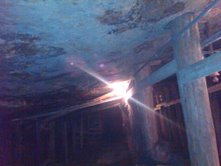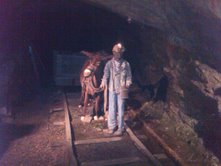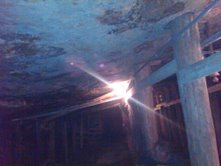
Ned Pelger's blog on construction, design and other weirdness. Email him at ned@constructionknowledge.net
Please help him win his readership competition against his son Lex at the Construction Phone Apps Blog
TBW and I are traveling for a few days, we headed north up Route 81 and stopped at the Lackawana Coal Mine tour. They take you 250 feet below grade into a deep anthracite mine. Riding in a coal car down the tracks, being lowered by a steel cable gave me the beginnings of the willies. I’m not crazy about enclosed spaces and wondered how I’d feel that far below grade. Like most anxieties, it was unwarranted. I was too interested in how things worked down there to be scared.
The mining process reminded me of a construction site on a day when one of the nastier jobs has to get done. Basically, it’s a big demolition project in which the coal veins get removed (except for a grid of coal columns that remain as structural supports) and the sandstone remains.
The wood posts, which I always thought were structural supports, aren’t near capable of supporting the rock and soil load above. The sandstone arches over the mining tunnels (about 15′ wide) and supports itself (until it doesn’t).
If the sandstone cracks or subsides in some way, the load above is huge. The wood posts start to snap, crackle and pop, acting as warning sounds that subsidence is occurring. The old saying goes, “When the props start talking, the miners start walking.” They also watched the rats, who had keener senses than humans and starting running for cover before the miners heard anything.

The photo above gives a sense of those supports while the donkey shown below shows how they did it in the old days. Some of the boys started working in the mines at 7 or 8 years old and were called “Nippers”.

Generally the drilling, blasting, waiting for the dust to settle, then cleaning the debris doesn’t seem too different from construction demo. Then I heard about monkey veins. Sometimes the coal veins were 10′ high and easy to work in. Other times, though, the veins may only be 2′ to 3′ high. Then the miners needed to work all day on their hands and knees or on their bellies. They only got paid by the car load, so working in a monkey vein just meant you had to work harder for the same pay. The photo below shows a monkey vein.

So you may be tired after a hard day, but remember it’s not a day in the mines.